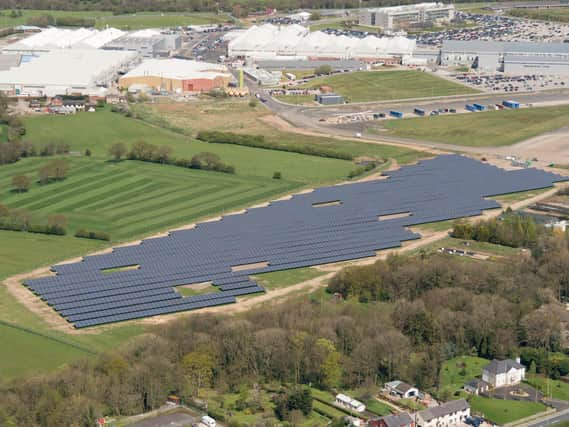Solar farm powers jet manufacturing for BAE Systems in Lancashire


Since its installation in mid-2015, nearly 9,000 solar panels have been providing power to BAE Systems’ facility in Samlesbury, producing around 2,300MWh of electricity every year to help power the site.
The panels have provided around four per cent of the site’s total consumption, and provides around a fifth of the site’s peak electrical demand.
Advertisement
Hide AdAdvertisement
Hide AdThat power is required to manufacture component parts for the Eurofighter Typhoon and F-35 Lightning II aircraft as well as the Hawk jet training aircraft.
The use of this solar energy prevented around 500 tonnes of carbon emissions during 2020, and over 4,500 tonnes of carbon emissions since its inception.
Stuart Barker, Carbon Net Zero Lead, Air Sector, said: “Since their installation, the panels at Samlesbury have helped to avoid a significant amount of carbon being released to the global environment every year, thus reducing our impact on climate change.
“By utilising part of the site’s former runway for the panels, we’ve been able to make a positive impact to the environment and at the same time helped to reduce energy costs and contributing to the affordability of our products and services to our customers across the globe.
Advertisement
Hide AdAdvertisement
Hide Ad“A large amount of investment has gone into developing Samlesbury over the last decade or so, and every investment has been considered with the environmental impact in mind – whether that’s the design of new buildings, or energy efficient plant and equipment.”
In addition to the electricity generated by the solar farm, all the electricity consumed on site is provided from renewable sources.
BAE Systems says its technology strategy is driven by the challenges that its customers are facing now and will face in the future.
It says customers not only need next-generation technologies to complete their missions successfully, but many have also reiterated their commitment to improving sustainability through reducing their environmental impact.
Advertisement
Hide AdAdvertisement
Hide AdBAE Systems is working on a range of technologies – like low-emission propulsion, energy storage, augmented and virtual reality, artificial intelligence, automation – to help them to fulfil these ambitions, as well as working to reduce the environmental impact of its own activities.
One of its projects is the groundbreaking unmanned PHASA-35.
It is being worked on by engineers at Warton and partner firm Prismatic, and is due to take to the air again from the US this summer to test its full range of equipment in the extreme cold of the upper atmosphere.
The carbon composite aircraft has a 35m wingspan but weighs just 150 kilos, about the same as two people, and can fly 12 miles high using the solar panels on its wings as power.
Advertisement
Hide AdAdvertisement
Hide AdBAE Systems says it will be an affordable alternative to satellites, carrying cameras and other sensors as well as mobile phone network technology.
But it will be better because it can circle over any particular area giving unbroken monitoring.